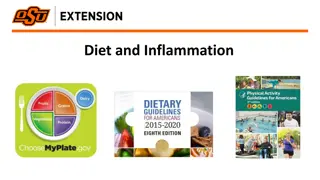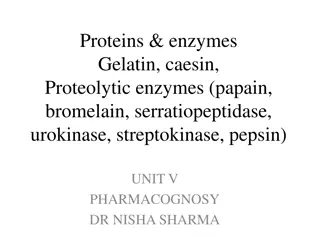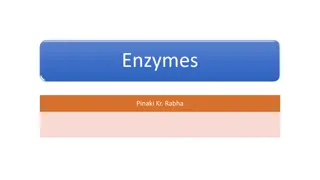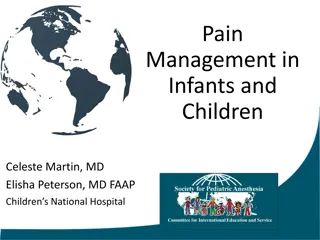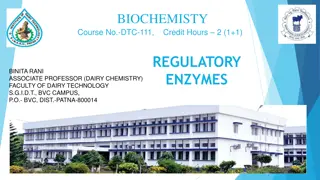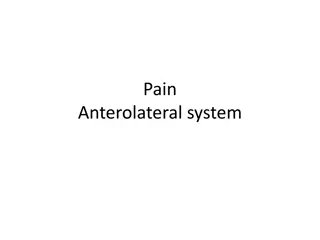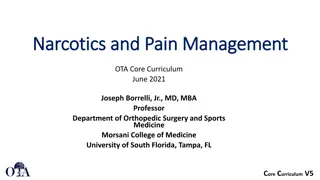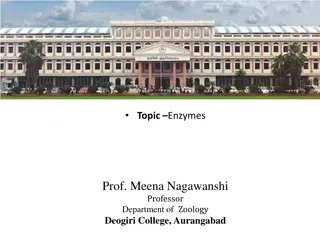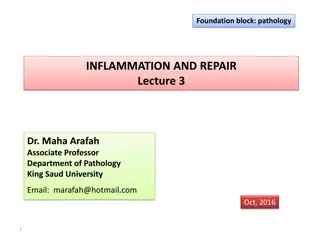Understanding COX Enzymes and Their Impact on Pain and Inflammation
COX enzymes, including COX1, COX2, and COX3, play a crucial role in synthesizing prostanoids like prostaglandins in the body, affecting pain and inflammation. By inhibiting these enzymes, relief from pain and inflammation can be achieved. However, non-selective COX inhibitors may lead to various side effects, including gastrointestinal complications and allergic reactions. It's essential to understand the differences between COX1 and COX2 and the potential risks associated with COX inhibitors.
Download Presentation

Please find below an Image/Link to download the presentation.
The content on the website is provided AS IS for your information and personal use only. It may not be sold, licensed, or shared on other websites without obtaining consent from the author. Download presentation by click this link. If you encounter any issues during the download, it is possible that the publisher has removed the file from their server.
E N D
Presentation Transcript
What is the COX? An enzyme called cyclooxygenase that use in synthesized of different type of prostanoids in the body. These prostanoids including prostaglandins, prostacyclin and thromboxane , they are important biological mediators that play important role in the development of pain and inflammation in the body. So it is possible to get relief from pain and inflammation by inhibiting the COX enzyme.
Types of COX : There are three different types of COX enzymes such as: COX1 COX2 COX3. They are similar in different aspects and have some differences too.
Difference between COX1 and COX2 COX1 COX2 constitutive enzyme inducible enzyme Name macrophages, leukocytes and fibroblasts. the synthesis of prostaglandins that causes pain and inflammation in the body. kidney, stomach and platelets Location as it protects gastric mucosa, regulate gastric acid and maintain normal functions of kidney by stimulating prostaglainds. continuous function dependent on cytokines production play an important role in inflammation and pyrexia. need inhibition protective in natur no need to inhibition Usefulness
Side effect of non selective COX inhibitor dark urine decreased frequency or amount of urine diarrhea difficult breathing drowsiness fainting fast breathing feeling that something terrible will happen fever general tiredness and weakness headache heartburn increased thirst indigestion Acid or sour stomach anxiety belching dizziness dry mouth hyperventilation Irritability shaking stomach discomfort, upset, or pain trouble sleeping unusual drowsiness, dullness, tiredness, weakness, or feeling of sluggishness irregular heartbeat
Incidence of side effect: allergy studies found that 1-2 % of NSAIDs patients shows allergic reaction including rash, urticaria, angioedema. GIT Effects - 10 20% of NSAID patients experience dyspepsia. In the 1990s high doses of prescription NSAIDs were associated with serious upper gastrointestinal adverse events, including bleeding.Over the past decade, deaths associated with gastric bleeding have declined. -According to the American Gastroenterological Association (AGA), each year the side effects of NSAIDs hospitalize over 100,000 people and kill 16,500 in the U.S., mostly due to bleeding stomach ulcers. -over 50% of patients who take NSAIDs have sustained some mucosal damage to their small intestine.
bronchospasm and asthma -The reported incidence varies widely affecting between 8% and 20% of adult asthmatics. Reye's Syndrome -About 90% of cases are associated with aspirin (salicylate) use in children. others -more than 30 million Americans use NSAIDs for pain from headaches, arthritis. -researchers estimate that NSAIDs would be responsible for up to 20 % of hospital admissions for congestive heart failure.
Discovery of selective cox 2 The COX-2 enzyme was discovered in 1988 by Daniel Simmons, a Brigham Young University researcher. The mouse COX-2 gene was cloned by UCLA scientist Dr. Harvey Herschman, a finding published in 1991] Celebrex (and other brand names for celecoxib) was introduced in 1999 and rapidly became the most frequently prescribed new drug in the United States Celecoxib was the first specific inhibitor of COX-2 approved to treat patients with rheumatism and osteoarthritis
celecoxib Celecoxib is a nonsteroidal anti-inflammatory drug (NSAID). It works by reducing hormones that cause inflammation and pain in the body.
Uses: Celecoxib is used to treat pain or inflammation caused by many conditions such as: ankylosing spondylitis menstrual pain. Osteoarthritis Rheumatoid arthritis to treat juvenile rheumatoid arthritis in children who are at least 2 years old. It is also used in the treatment of hereditary polyps in the colon.
Side effect: Celecoxib can increase your risk of fatal heart attack or stroke, especially if you use it long term or take high doses, or if you have heart disease. Do not use this medicine just before or after heart bypass surgery (coronary artery bypass graft, or CABG Celecoxib may also cause stomach or intestinal bleeding, which can be fatal. These conditions can occur without warning while you are using this medicine, especially in older adults. You should not take this medicine if you already have bleeding in your stomach or intestines.
Rofecoxib uses For relief of the signs and symptoms of osteoarthritis. For relief of the signs and symptoms of rheumatoid arthritis in adults. For the management of acute pain in adults. For the treatment of primary dysmenorrhea. For the acute treatment of migraine attacks with or without aura in adults. Side effect Gastrointestinal Serious gastrointestinal toxicity such as bleeding, ulceration, and perforation of the stomach, small or large intestine General: fatigue, dizziness, influenza-like disease Renal,ocular,hepatic,cardiovascular side effects :
Meloxicam is a nonsteroidal anti-inflammatory drug (NSAID) with analgesic and fever reducer effects
Uses & Benefits of Meloxicam 1-Rheumatoidartheritis It is an autoimmune disease disorder that affect joints.It results in warm swollen stiff and painful joint. 2-osteoartheritis It is a type of joint disease that result from breakdowen of joint cartilage and bone. 3-Juvenile rheumatoid artheritis The most common type of artheritis in children under the age of 17 years.It cause persistant joint pain and stiffess. 4-Acute inflammatory pain. 5-Ankylosing spondylitis It is a type of artheritis in which there is inflammation of the joints of the spine.
Side effects GIT: Stomach upset, nausea, dizziness, or diarrhea : CVS Persons with hypertension, high cholesterol, or diabetes are at risk for cardiovascular side effects Other: Headache,bleeding
NSAIDs vs. COX-2 inhibitors, which is better? COX-2 inhibitors impede prostaglandin production. COX-1 is an enzyme which is normally present in a variety of tissues in the body, including sites of inflammation and the stomach. Some of the prostaglandins made by COX-1 protect the inner lining of the stomach. Common NSAIDs such as aspirin block both COX-1 and COX-2. When the COX-1 enzyme is blocked, inflammation is reduced, but the protection of the lining of the stomach also is lost. This can cause stomach upset as well as ulceration and bleeding from the stomach and even the intestines.
The other cyclooxygenase, COX-2, also produces prostaglandins, but the COX-2 enzyme is located specifically in areas of the body that commonly are involved in inflammation but not in the stomach. When the COX-2 enzyme is blocked, inflammation is reduced; however, since the COX-2 enzyme does not play a role in protecting the stomach or intestine, COX-2 specific NSAIDs do not have the same risk of injuring the stomach or intestines. Old NSAIDs (for example, aspirin, ibuprofen, naproxen, etc.) all act by blocking the action of both the COX-1 and COX-2 enzymes. COX-2 inhibitors selectively block the COX-2 enzyme and therefore have a lower risk of causing ulcers of the stomach or intestine.
Group 6 651 660 / /





